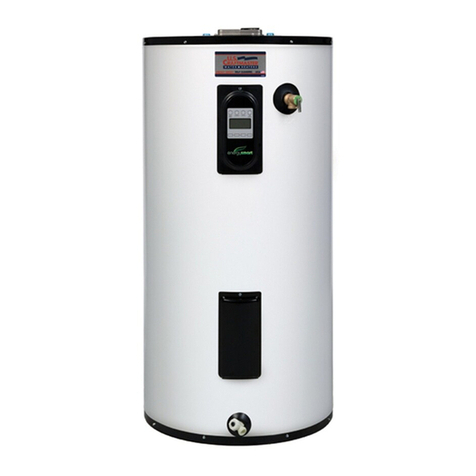
Residenal Standard Gas Water Heater Use and Care Guide • 5
SAFETY
Residenal Standard Gas Water Heater Use and Care Guide • 5
IMPORTANT SAFETY INFORMATION
• If the water supplied to the water
heater is pre-heated (for example,
by a solar system) the temperature
in the tank may be higher than the
water heater’s temperature seng.
• Should overheang occur or the
burner fail to shut off, turn offthe
manual gas supply valve to the water
heater and call a qualified person.
To reduce the risk of unusually hot wa-
ter reaching the fixtures in the house,
install Thermostac Mixing Valves at
each point-of-use.
If anyone in your home is at parcular
risk of scalding (for example, the elder-
ly, children, or people with disabilies)
or if there is a local code or state law
requiring a certain water temperature
at the hot water tap, these precauons
are parcularly important.
According to a naonal standard (ASSE
1070) and many local plumbing codes,
the water heater’s gas control valve
should not be used as the sole means
to regulate water temperature and
avoid scalds.
Properly adjusted Thermostac Mixing
Valves installed at each point-of-use al-
low you to set the tank temperature to
a higher seng without increasing risk
of scalds. A higher temperature seng
allows the tank to provide much more
hot water and can help provide proper
water temperatures for appliances such
as dishwashers and washing machines.
Higher tank temperatures (140°F)
also kill bacteria that cause a condi-
on known as “smelly water” and can
reduce the levels of bacteria that cause
water-borne diseases.
Water Contaminaon Risk
Do not use chemicals that could con-
taminate the potable water supply. Do
not use piping that has been treated
with chromates, boiler seal, or other
chemicals.
Fire Risk
This water heater is
equipped with a Flam-
mable Vapor Ignion
Resistance (FVIR) system.
FVIR is designed to reduce the risk of
flammable vapor-related fires. FVIR
makes this product more sensive to
installaon errors or improper installa-
on environments. The FVIR system will
not prevent a possible fire/explosion if
the igniter is depressed and flammable
vapors have accumulated in the combus-
on chamber with the pilot light off.
Do not aempt to light this appliance,
or depress the igniter buon, if you
suspect flammable vapor have accumu-
lated inside or outside the appliance.
Immediately call a qualified person to
inspect the appliance. Water heaters
subjected to a flammable vapors inci-
dent will show a discoloraon on the
flame arrestor and require replacement
of the enre water heater. Improper
installaon or an inadequate air supply
can also cause the FVIR system to dis-
able the water heater.
WARNING! This water heater has a
reseable thermal switch installed as
part of the FVIR system. Do not
aempt to disable or modify this
feature in any way. Doing so can lead
to fire, explosion or excessive and
abnormal producon of carbon
monoxide.
To reduce the risk of a fire that could
result in property damage, or serious
injury or death:
• Do not store things that can burn
easily such as paper or clothes next
to the water heater.
• Do not store or use gasoline or other
flammable substances in the vicinity
of this or any other appliance.
• Keep the water heater from becom-
ing wet. Immediately shut the water
heater offand have it inspected by a
qualified person if you find that the
wiring, thermostat(s) or surround-
ing insulaon have been exposed
to water in any way (e.g., leaks from
plumbing, leaks from the water
heater itself can damage property
and could cause a fire risk). If the
water heater is subjected to flood
condions or the thermostat(s) have
been submerged in water, the enre
water heater must be replaced.
• Replace the water heater’s viewport
if glass is missing or damaged. Repair
the combuson chamber door seals
if damaged.
Explosion Risk
High temperatures and
pressures in the water
heater tank can cause an explosion re-
sulng in property damage, serious in-
jury or death. A new Temperature and
Pressure (T&P) Relief Valve is included
with your water heater to reduce risk
of explosion by discharging hot water.
Addional temperature and pressure
protecve equipment may be required
by local codes.
A naonally recognized tesng labo-
ratory maintains periodic inspecon
of the valve producon process and
cerfies that it meets the requirements
for Relief Valves for Hot Water Supply
Systems, ANSI Z21.22. The T&P Relief
Valve’s relief pressure must not exceed
the working pressure rang of the wa-
ter heater as stated on the rang plate.
Maintain the T&P Relief Valve properly.
Follow the maintenance instrucons
provided by the manufacturer of the
T&P Relief Valve (label aached to T&P
Relief Valve). An explosion could occur




























